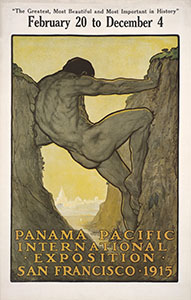The Fine Arts Museums of San Francisco are now presenting Jewel City: Art from San Francisco's Panama-Pacific International Exposition, on view at the de Young from October 17 through January 10, 2016.

Perham Wilhelm Nahl (American, 18691935), The Thirteenth Labor of Hercules: Official Poster for the Panama-Pacific International Exposition, 19131914. Collection of Donna Ewald Huggins
By Paul Duclos
Published: November, 2015
The Fine Arts Museums of San Francisco are now presenting Jewel City: Art from San Francisco’s Panama-Pacific International Exposition, on view at the de Young from October 17 through January 10, 2016.
Celebrating the centennial of the 1915 Panama-Pacific International Exposition (PPIE) in San Francisco, this exhibition revisits a vital moment in the inauguration of San Francisco as a cultural center on the West Coast.
The PPIE was a world’s fair hosted by San Francisco to commemorate the opening of the Panama Canal and also served to promote the area’s recovery following the 1906 earthquake. At the heart of the PPIE was one of the most ambitious art exhibitions ever presented in the United States. It included a comprehensive survey of American painting, sculpture and printmaking as well as European works drawn from international public and private collections.
“The curatorial team has spent more than three years assembling this ambitious exhibition that recreates highlights of the original exposition of 1915,” said James Ganz, curator of the Achenbach Foundation for Graphic Arts at the Fine Arts Museums of San Francisco and lead curator of Jewel City. “Our efforts to identify and locate actual works of art shown in the PPIE have led from our own storerooms to holdings as far away as Budapest, Hungary. In a way, we are following in the footsteps of the original organizers as we bring back to San Francisco a compelling array of significant works by American and European artists last seen together here a century ago.”
Jewel City will present a series of galleries devoted to the main artistic venues of the fair—the Palace of Fine Arts and the Fine Arts Annex—as well as the French Pavilion, bringing together more than 200 paintings, sculptures, prints and photographs by major American and European artists that were among the works on view at the PPIE, which numbered an estimated 20,000.
Jewel City features works from more than 70 international lenders as well as works drawn extensively from the museums’ own permanent collections. These artworks have not been seen together in the 100 years since the PPIE was held, and they may never be reunited in an exhibition again.
Among the featured paintings are Winslow Homer’s Saco Bay (1896), a dramatic seascape set near the artist’s home at Prouts Neck, Maine, as well as The Sketchers (1913) by John Singer Sargent, a painting of artists working en plein air. Jewel City will also display photographs by Ansel Adams, Paul Strand, Edward Weston and Imogen Cunningham.
Matthew Shilvock has been named new general director of San Francisco Opera. He will begin his five-year contract on August 1, 2016. He fills the shoes of David Gockley, who will retire next July, concluding a 44-year career as opera impresario.
Here, in an exclusive interview, Mr. Gockley shares some insights regarding the San Francisco Opera:
Bay Crossings: Our readers spend a good part of their commute listening to radio broadcasts, podcasts, and recordings on their portable devices. Any advice for them on how to prepare for the opera season?
David Gockley: There is ample material on our website (sfopera.com) including a preview of each opera that I research and produce.
BC: The San Francisco Opera Guild’s “insight panels” also provide a great educational opportunity. Can you tell us more about how these are put together?
Gockley: The guild arranges for the space. We provide the panelists.
BC: Each of the productions this season pose their own unique challenges in staging, casting, and orchestration. Can you give us a few examples of how SFO if using innovation to get over these hurdles?
Gockley: The production of Lucia di Lammermoor uses very high resolution projections to create many different stage pictures at a surprisingly reasonable cost.
BC: Now a little bit about you. As general director you have a frantic social agenda and extremely complex management duties. Can you describe your daily routine during the season?
Gockley: I go to work between 9:00 and 9:30 a.m. Meetings and desk work consume the day. I stay for many—but not all—performances, but remain through the first intermission unless I’m out of town.
BC: When you do have time to relax, what are your favorite activities?
Gockley: Walking in the Marin Headlands and sailing on the Bay.
BC: Finally, can you sum up how SFO has evolved since you first took the helm? What is your vision for this season and beyond?
Gockley: We have become more accessible, including via a number of electrically-conveyed platforms: Opera at the Ballpark, KDFC and international radio, West Coast cinemas and KQED telecasts.
Follow Paul Duclos’ Cultural Currents online with his blog at:paulduclosonsanfranciscoculture.blogspot.com

